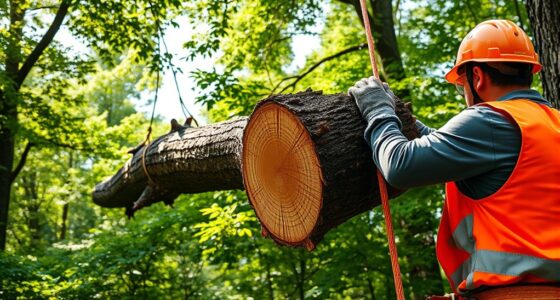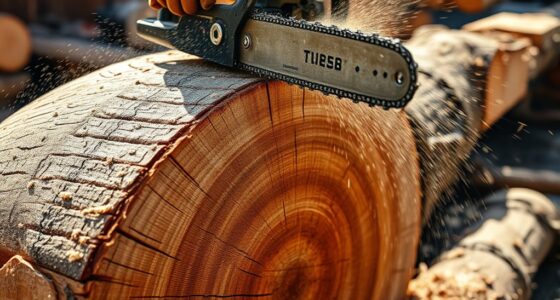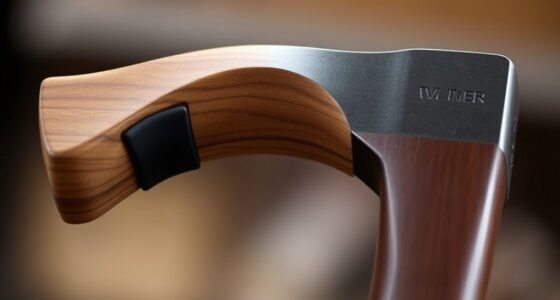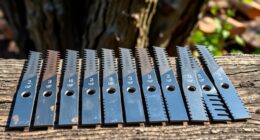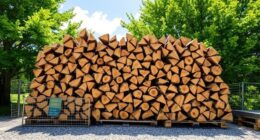To select the right chainsaw bar length, consider your project needs, your skill level, and your chainsaw’s specifications. Shorter bars (around 14 inches) give you better control for lightweight work like pruning or trimming. Longer bars (over 20 inches) are suited for heavy-duty felling and larger logs. Proper sizing guarantees safety, efficiency, and durability. If you want to know how to measure your current bar and match it accurately, keep exploring for expert tips.
Key Takeaways
- Match the bar length to your project size and type, such as pruning, firewood, or large tree felling.
- Consider your chainsaw’s power and motor capacity; avoid overmatching longer bars that may strain the engine.
- Ensure safety and control by choosing a bar length suitable for your skill level, especially for beginners.
- Regularly measure your current bar to confirm compatibility and determine if replacement or upgrade is needed.
- Balance bar length with maneuverability, safety, and maintenance requirements for efficient and safe operation.
Understanding Chainsaw Bar Sizes

Understanding chainsaw bar sizes is essential for choosing the right tool for your needs. The size impacts bar durability and how well the chain tension stays consistent during use. A properly sized bar ensures the chain runs smoothly, reducing wear and tear on both parts. Larger bars can handle bigger logs but may require more power and could increase chain tension issues if not matched correctly. Smaller bars are easier to maneuver and maintain, offering better control for lighter tasks. Always consider the bar length in relation to your project, and check that it’s compatible with your chainsaw’s specifications. Knowing the appropriate bar length for your specific tasks can help prevent unnecessary wear and improve overall safety. Additionally, selecting the correct bar material can influence its lifespan and performance under different working conditions. Proper maintenance and understanding of bar specifications can further enhance your chainsaw’s efficiency and longevity. By understanding these factors, you’ll select a bar that enhances performance, prolongs durability, and maintains proper chain tension throughout your work.
Common Bar Lengths and Their Uses
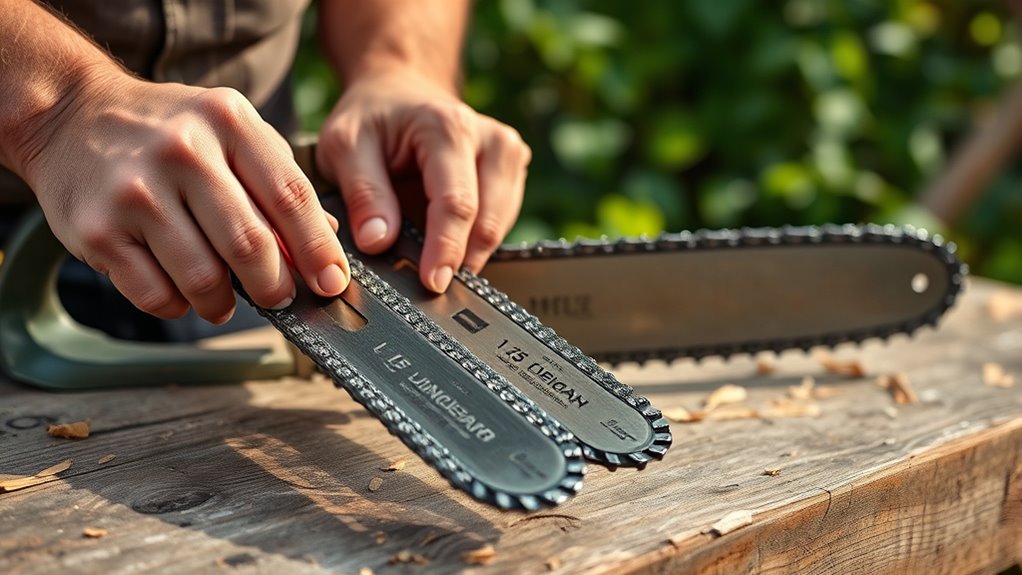
Common chainsaw bar lengths vary widely to match different tasks, making it important to select the right size for your projects. Shorter bars, around 14 inches, are ideal for pruning, trimming, and small cutting jobs, allowing for better control and precision. Medium bars, 16 to 20 inches, suit general cutting tasks like firewood and small to medium tree felling. Longer bars, over 20 inches, are designed for heavy-duty felling and large-scale timber work, but they require more power and skill. Keep in mind, a longer bar means more chain length, which can impact chain sharpening and bar lubrication. Regular maintenance, including chain sharpening and proper bar lubrication, guarantees your chainsaw performs efficiently, regardless of bar length. Additionally, understanding the industry transformations such as AI automation and innovative logistics solutions can help you stay informed about the latest tools and techniques that enhance your work. Staying updated on technology advancements can improve your efficiency and safety when operating different chainsaw setups. Selecting an appropriate chainsaw setup tailored to your specific tasks ensures optimal performance and safety. Being aware of the latest safety standards can also prevent accidents and improve overall efficiency during operation. For example, incorporating sound therapy principles into your safety training can promote better focus and reduce operator fatigue.
Matching Bar Length to Your Projects
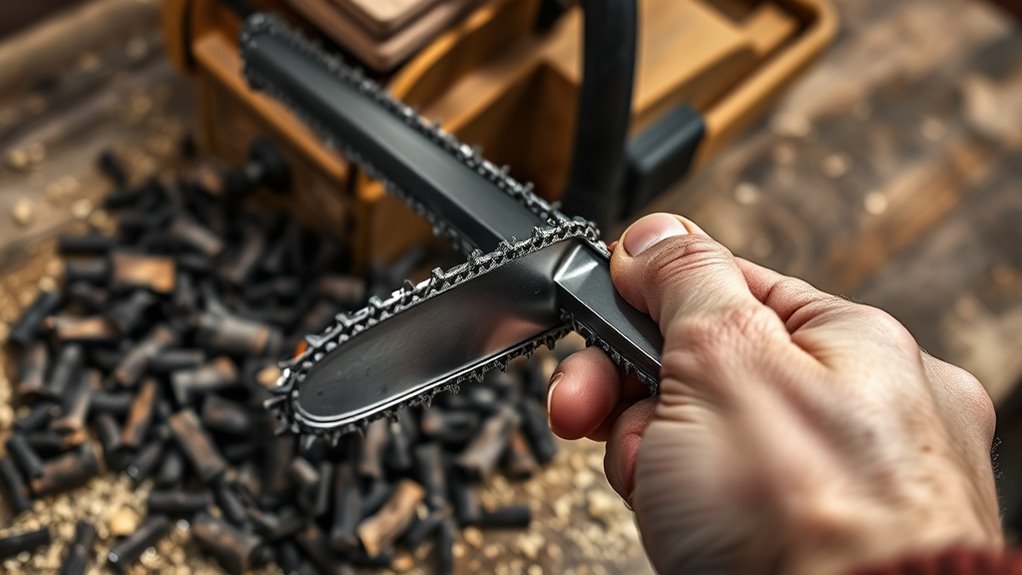
Choosing the right bar length depends on the projects you’ll tackle. Consider the type of work, like pruning or heavy-duty cutting, and the size of the trees you’ll be working on. Your handling and maneuverability also matter, ensuring you can control the saw comfortably and safely.
Project Type Compatibility
Selecting the right chainsaw bar length depends heavily on the types of projects you’ll tackle. For light pruning or small cutting jobs, a shorter bar (around 14 inches) offers better control and precision. If you’re doing more extensive work like cutting firewood or felling small trees, a longer bar (18-20 inches) boosts efficiency. Consider your project’s demands; larger bars handle bigger cuts but require more power and stability. When performing chain repair, ensure the bar length suits your tasks to avoid unnecessary strain. Proper bar lubrication is essential regardless of size, reducing wear and preventing overheating. Matching your bar length to your project type ensures safer operation, quicker cuts, and less fatigue, making your work more effective and enjoyable. Being aware of project requirements can also help you select the optimal bar length to improve overall safety and performance during your tasks. Additionally, understanding chainsaw safety practices is crucial for preventing accidents and ensuring efficient work. Recognizing patterns of emotional coldness can also help prevent relationship strain when balancing work and personal life. Proper maintenance and awareness of tool capabilities will further ensure that your chainsaw performs reliably for your specific projects, especially when considering cookie categories that impact your overall experience.
Tree Size Considerations
Matching your chainsaw’s bar length to the size of the trees you plan to cut guarantees safer, more efficient work. Smaller trees require a shorter bar to prevent unnecessary stress on the saw and protect tree health. Larger trees demand longer bars to cut effectively without overexerting the engine. Consider these points:
- Use a bar 12-16 inches for small to medium trees to ensure clean cuts and reduce environmental impact.
- Opt for a 16-20 inch bar for larger trees, balancing power and safety.
- Avoid overly long bars for small trees, as they can damage the tree’s health and increase the risk of kickback.
- Being aware of the aroma of bleach can help maintain a safe and healthy working environment around your equipment.
Matching bar length to tree size helps safeguard the environment and ensures your work is safer and more sustainable.
Handling & Maneuverability
When handling different projects, the bar length of your chainsaw directly impacts maneuverability and control. A shorter bar offers better ergonomics and comfort, making it easier to maneuver in tight spaces or when precision is essential. It also improves weight distribution, reducing fatigue during extended use. Additionally, proper bar length selection can help prevent accidents and improve overall safety. Understanding the appropriate bar length for your specific project ensures you choose a tool that matches your needs. Conversely, a longer bar provides increased cutting capacity but can be more cumbersome, requiring greater strength and control. Consider your project’s scope and your physical comfort when choosing a bar length. A well-matched bar enhances handling, minimizes strain, and improves safety. Balancing the saw’s weight and ergonomics guarantees you maintain control throughout your work, whether you’re trimming branches or felling trees. Selecting the right length ultimately makes your tasks more efficient and comfortable. Additionally, understanding the chain attachment standards can ensure compatibility and optimal performance of your chainsaw. Proper stability and support during operation also contribute to safer and more effective cutting.
Assessing Your Skill Level and Safety Considerations

Your skill level plays a big role in choosing the right chainsaw bar length, as handling larger bars requires more experience. Safety should always come first, so pick a size that you can manage confidently. Establishing healthy screen time habits and boundaries is essential for maintaining focus and safety during operation. Prioritizing safety measures helps prevent accidents and ensures you work efficiently. Additionally, understanding the best tools for safety can help you make more informed decisions when selecting equipment. Being aware of proper maintenance techniques can also extend the lifespan of your chainsaw and improve safety during operation. Incorporating proper safety gear is essential for protecting yourself while working with different bar lengths.
Skill Level Impact
Choosing the right chainsaw bar length depends heavily on your skill level and safety awareness. If you’re just starting, shorter bars promote better control and reduce risk during operation. As you develop your skills, you can handle longer bars, but only after completing safety training and building confidence. Keep these points in mind:
- Prioritize safety during skill development to minimize accidents.
- Match your bar length to your current experience to ensure safe handling.
- Gradually increase bar length as your skills and safety awareness improve.
Prioritize Safety Measures
Evaluating your skill level and safety considerations is essential before selecting a chainsaw bar length. You should always prioritize safety gear, such as goggles, gloves, and hearing protection, to minimize injury risks. Proper safety measures also include understanding emergency preparedness, like knowing how to quickly shut off your chainsaw and having a first aid kit nearby. If you’re a beginner, choose a shorter bar for better control and reduced danger. As your skills improve, you can consider longer bars, but never compromise safety for power. Always assess your comfort level and experience before handling larger tools. Staying vigilant about safety helps prevent accidents and ensures you work confidently, regardless of the chainsaw bar length you choose.
Factors Influencing Bar Selection
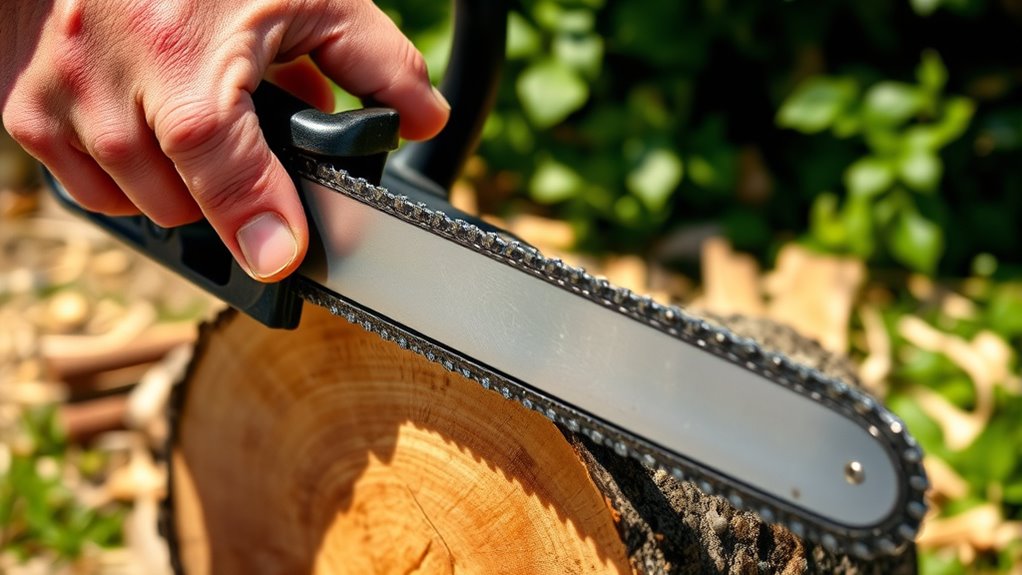
Several key factors influence your decision when selecting a chainsaw bar length. First, consider your typical cutting tasks; larger bars handle bigger logs, but shorter bars offer better control. Second, your chainsaw’s power must match the bar length; an undersized bar can strain the motor. Third, regular chain lubrication and bar sharpening are essential; longer bars require more maintenance to prevent wear and guarantee smooth operation.
How to Measure Your Current Bar

To accurately determine your current chainsaw bar length, start by unplugging the saw and placing it on a flat, stable surface. Carefully remove the chain, then measure from the tip of the bar to the crankcase where the bar enters the saw. Use a measuring tape or ruler for precision. Keep in mind, your bar length affects chain lubrication and bar sharpening; a longer bar requires more attention to chain tension and lubrication. Regularly check these to ensure safe operation. Use the table below to record your measurements:
| Part Measured | Description |
|---|---|
| Tip to Crankcase | Length of the bar from tip to mounting point |
| Chain Length | Length of chain on the bar |
| Chain Tension | Tightness of the chain during use |
| Bar Width | Thickness of the bar |
| Chain Lubrication | Check if lubrication is adequate |
This will help you assess your current setup accurately.
Choosing the Right Chain and Bar Compatibility
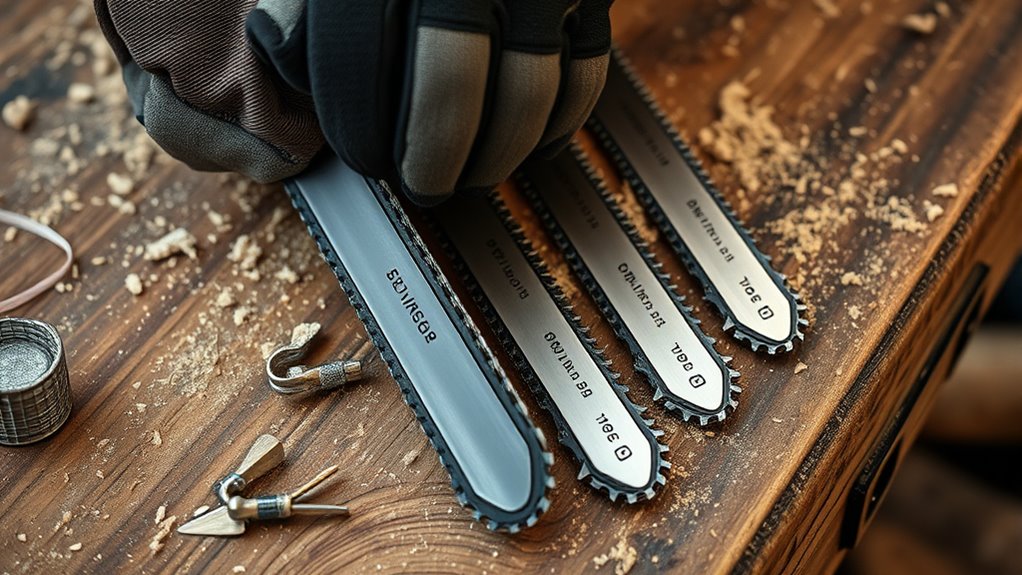
Choosing the right chain and bar compatibility is essential for your chainsaw’s performance and safety. If the chain doesn’t match the bar length or gauge, it can cause inefficient cutting or safety hazards. To guarantee proper operation, focus on these key points:
- Match the chain gauge to the bar’s groove for smooth chain movement and effective chain lubrication.
- Verify the chain pitch aligns with the bar’s specifications to prevent slipping or binding.
- Regularly check chain tension and ensure proper bar lubrication for ideal cutting and to reduce wear.
Using incompatible chains can lead to poor chain lubrication, increased friction, and potential damage. Always consult your chainsaw manual or a professional to confirm compatibility, ensuring safe and efficient cutting.
Tips for Maintaining and Replacing Your Bar
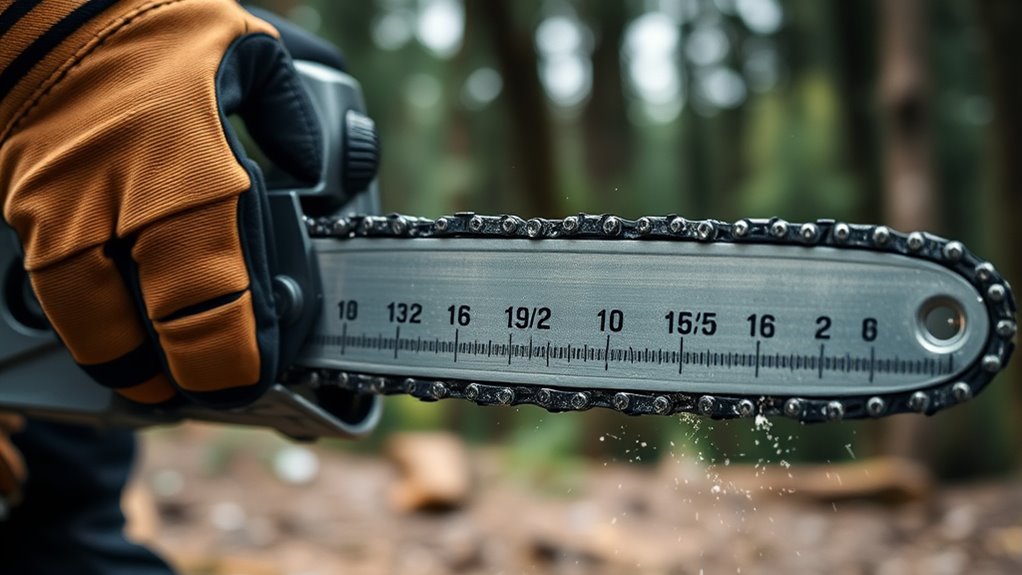
Proper maintenance and timely replacement of your chainsaw bar are essential for safe and efficient operation. Regularly check the bar for signs of wear, such as uneven or excessive grooving, and replace it when necessary. To keep your bar in good shape, ensure proper bar maintenance by cleaning debris and sawdust after each use. Proper chain lubrication is crucial; it reduces friction, prevents overheating, and minimizes wear on both the chain and the bar. Always use the right oil and check your lubrication system regularly. When replacing the bar, select one that matches your chainsaw’s specifications and ensures smooth operation. Taking care of your bar not only extends its lifespan but also improves cutting performance and safety during every use.
Troubleshooting Common Bar Length Issues
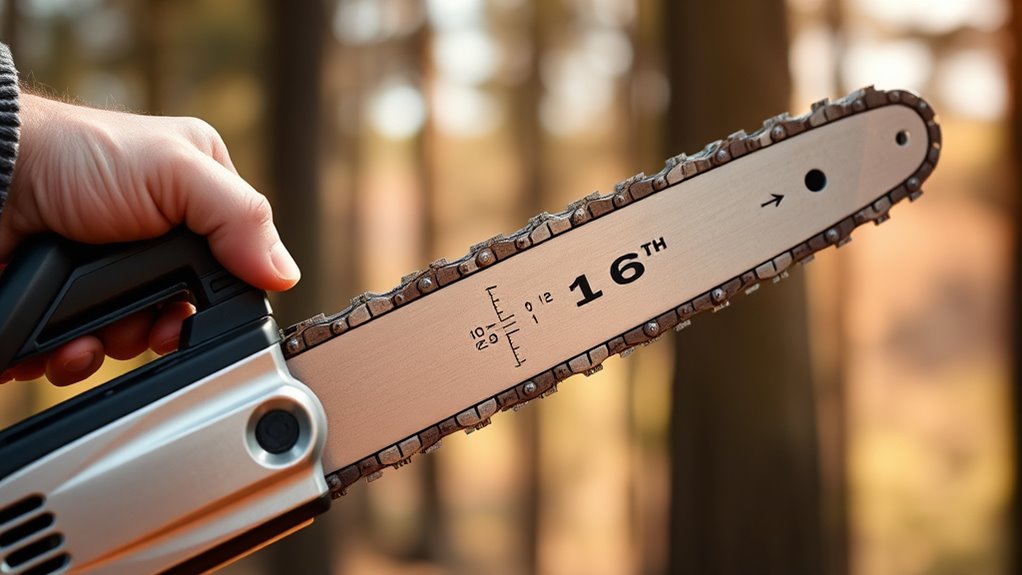
When your chainsaw isn’t cutting efficiently or seems to struggle with thicker wood, bar length issues might be the culprit. An incorrect bar length can cause improper chain tension, uneven cuts, and increased wear. To troubleshoot:
- Check if the bar length matches your project needs; too long or short can hinder performance.
- Ensure you’re applying enough chain oil and maintaining proper bar lubrication; poor lubrication can cause overheating and uneven wear.
- Inspect the chain tension—incorrect tension affects cutting efficiency and can indicate incompatible bar length.
If the bar is too long, the chain may not engage fully, reducing power. Conversely, a too-short bar limits cutting capacity. Proper maintenance and matching bar length to your task keep your chainsaw running smoothly.
Frequently Asked Questions
Can I Use a Longer Bar for More Cutting Power?
Using a longer bar won’t necessarily give you more cutting power, but it does increase bar weight and affects maneuverability. You might find it harder to control and handle, especially for detailed or tight cuts. While a longer bar can cut larger branches or logs more efficiently, consider your strength and the task at hand. For easier handling, choose a length that balances power, control, and comfort.
How Does Bar Length Affect Chain Speed?
Bar length impacts chain speed, affecting how quickly and efficiently you cut. A longer bar can cause more chain vibration, making the chain less stable and reducing cutting precision. With increased vibration, you might notice slower chain movement or uneven cuts, which can be frustrating. Shorter bars offer better control, less vibration, and more consistent chain speed, helping you achieve cleaner cuts and safer handling during your projects.
Are Longer Bars Suitable for All Tree Types?
Longer bars aren’t suitable for all tree types because they can affect chain stability and make handling more difficult. They work best for larger, thicker trees where deep cuts are needed. However, for smaller or delicate trees, shorter bars provide better control and safety. Always check bar compatibility with your chainsaw and consider the tree size and type to guarantee safe, efficient cutting.
What Are the Risks of Using an Incorrect Bar Length?
Using an incorrect bar length can pose safety concerns, increasing the risk of kickbacks or loss of control during cutting. It also leads to maintenance challenges, as the chainsaw may strain more or wear unevenly. You might find it harder to maneuver, increasing fatigue and accident risk. To stay safe and keep your equipment in good shape, always choose a bar length suited to your specific cutting tasks.
How Does Bar Length Influence Fuel Efficiency?
Bar length considerably impacts your chainsaw’s fuel efficiency. A longer bar requires more power, leading to increased fuel consumption and less efficiency. Conversely, a shorter bar uses less energy, helping you optimize fuel usage for lighter tasks. To boost efficiency, choose a bar length suited to your job size. This way, you minimize unnecessary strain on the engine, ensuring efficiency optimization and conserving fuel during your projects.
Conclusion
Choosing the right chainsaw bar is like finding the perfect tool for a craft—you’ll work more efficiently and safely. When you select a bar that fits your projects and skill level, cutting becomes smoother and more enjoyable. Remember, a well-matched bar is the backbone of your chainsaw’s performance. Take your time, measure carefully, and stay safe—because the right choice makes all the difference, just like the perfect key fits its lock perfectly.


